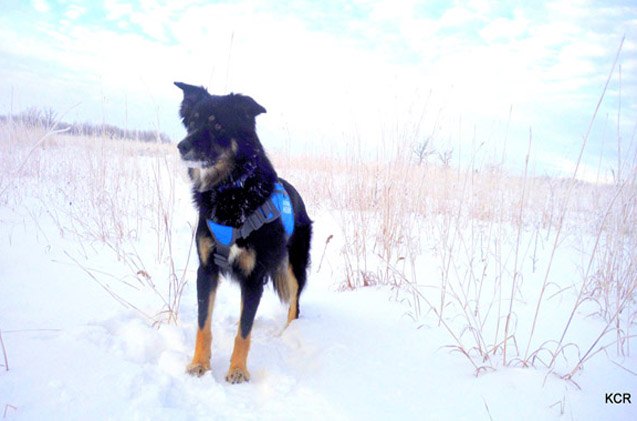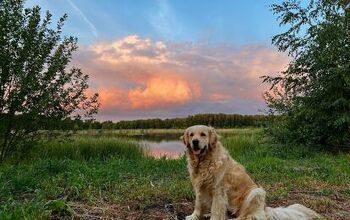Secrets of Canadian Mushers: Why Dog Boots and Deep Snow Don’t Mix

Dreaming of snowshoeing through some fresh power with your pup this weekend? I am right there with you, but please leave the dog boots at home. Your dog doesn’t need them.
I can hear the disbelief from here… “But won’t my dog will get cold?”
First off, dogs are amazing! And that’s especially true when it comes to regulating their body temperature. Canines have the ability to keep warm in winter temperatures by lowering their metabolic rate. As the days grow shorter, they undergo hormonal changes that slow their metabolism. This allows dogs to prepare for winter by increasing their body fat. Some of this fat is stored in their paw pads, which acts as insulation against the cold.
But you say that your dog is lifting his paws and isn’t able to keep warm? Take a look at what you’re feeding them. Adding a bit more fat to his diet will give your dog a little more energy to burn, keep warm, and walk through the deep snow. If he’s still lifting his paws, plan your outing to be shorter next time.
Cold is Relative
Every dog experiences cold differently. A dog living up north will be far more used to the cold than a dog lounging on a southern beach. Acclimatizing to the weather will be determined by how big your dog is and what sort of natural protection they have, as well as his age.
Tiny dogs, old dogs, hairless dogs, and puppies have a harder time regulating their body temperature in cold weather. I suggest skipping out on the snowy powder play with them. They likely won’t have as much fun, and extended time in the cold can prove to be dangerous.
Holy Ice Balls!
You still aren’t convinced? Are you worried your dog will get ice balls between his toes? That’s a real concern. Ice balls are uncomfortable and can cause injury.
With each step your dog takes, snow becomes compacted under the paw and between the toes. Some of this snow falls away, but some sticks to the hair between the toes and under the feet. Every little drop of snow that sticks to the foot collects more snow with each step. In the wrong conditions, ice balls can form quickly. These accumulations force the toes to spread, resulting in a painful walk.
So how do you prevent ice balls? Trim. Wax. Rewax as needed.
That’s it. Trim the hair up between your dog’s toes, using a proper pet hair trimmer with a guard. Ditch the scissors for the job, as you don’t want to accidentally nick or cut your dog’s tender toes or pads. Some dogs are going to need regular haircuts, so keep an eye on those hairy hobbit-footed dogs.
Wax On
After the paw haircut, it’s time for a wax. Grab a jar of paw wax, and apply right before you hit the trails. Some people recommend cooking spray or vegetable oil. But some people are wrong. Bad ideas are all over the Internet. Paw wax is preferable to use as it’s formulated to stay on a dog’s paws in cold temperatures. A wax is thicker than cooking spray and will stay on longer. In cold temperatures or during long runs, wax will still need to be reapplied, so tuck a small jar into your pocket with you.
Don’t want to take your mitts off to wax your dog’s paws? Some brands of paw wax are sold in bar form. Or use this cool trick – turn a locking sandwich bag inside out. Put the bag on top of your mitt and apply the wax. When you finish, simply turn the bag right side out again and stash it in your pocket.
But… still, with the boots?
You like playing in the snow, your dog likes playing in the snow. You wear a jacket. Your dog wears a jacket. You like pizza. Your dog likes pizza. You wear boots… but your dog doesn’t need to, right? Boots are good for dogs in certain winter situations. Boots can be great for protecting against road salt, or abrasive icy trails, but they are not meant for deep snow. Boots and deep snow are just a bad mix.
Remember how we talked about how the ice balls forms between your dog’s toes? If snow gets down through the top of the boot (and it will), each time the dog steps forward it opens a little more room for more snow to fall down. As the snow is trapped against the leg or foot, the body heat of the dog melts it to form small balls of ice right against the skin. As more and more snow accumulates against the dog’s foot or leg, the snow starts to pull the hair up and away from the skin. The skin is left irritated and in danger of frostbite.
Get out and play with your dog, but if you are headed for the deep snow, leave the boots at home.

Kevin Roberts lives for adventure. Together with his pack of rescue dogs and his husband, he spends as much time outdoors as possible. Kevin lives by the motto: "Get outside and play with your dogs!
More by Kevin Roberts


























